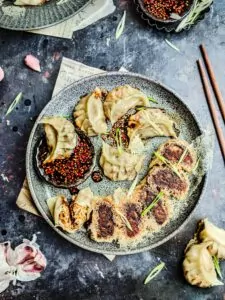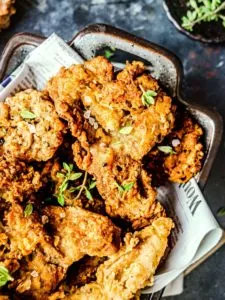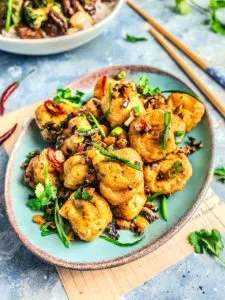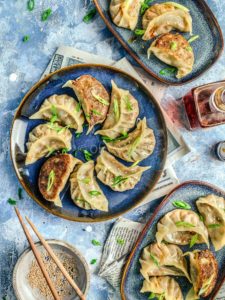Wild Garlic Falafel
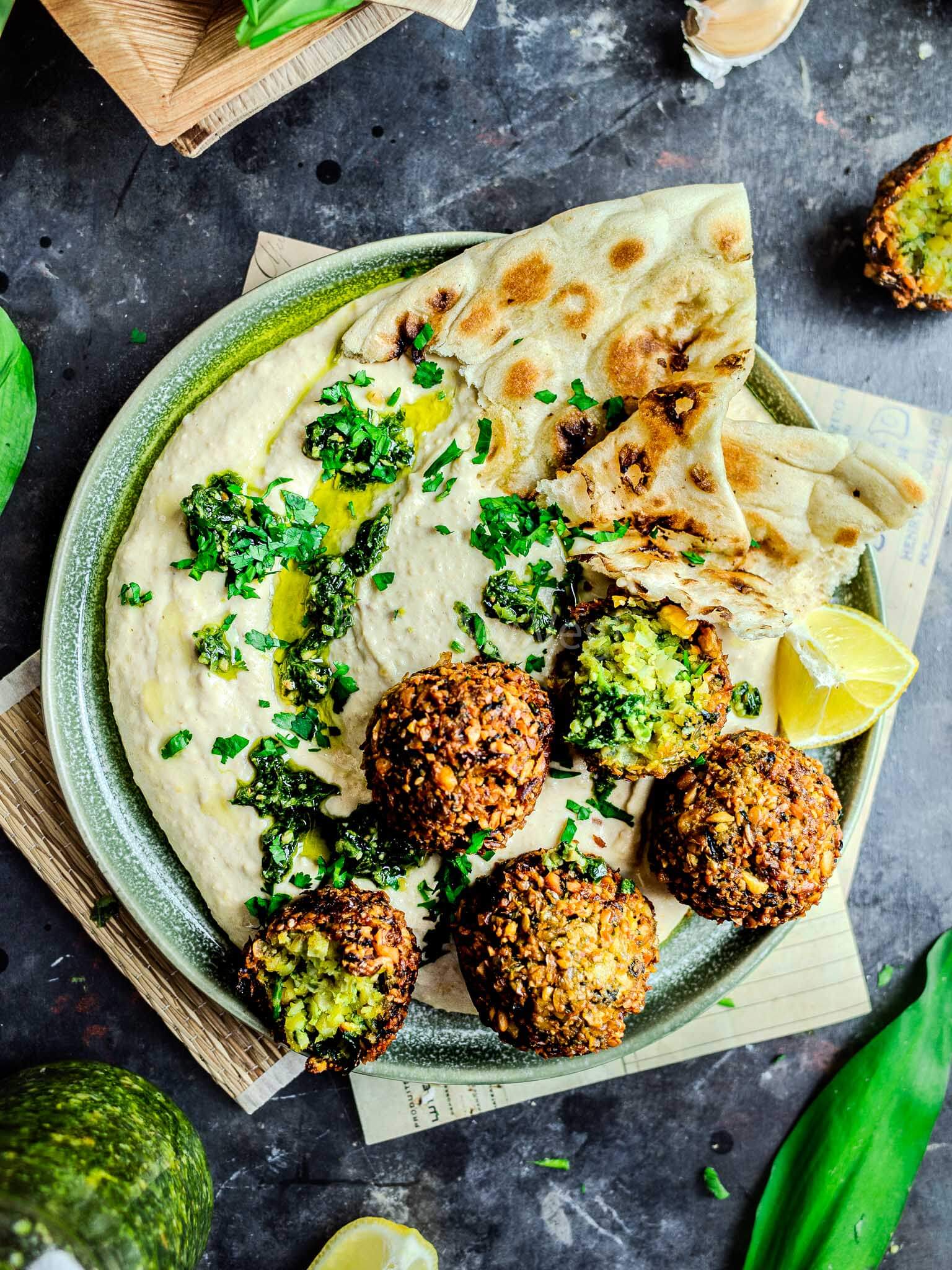
I’m utterly obsessed with wild garlic. From wild garlic pesto, wild garlic pakoras, wild garlic scones, wild garlic pea risotto, and these wild garlic falafels, all my springtime meals have involved wild garlic in some form or another!
If you’re an avid forager like me, you probably look forward to springtime all year round. It’s not just the joy of cold days finally passing, the sun setting later, or the paths lined with pink and white blossom trees — it’s the scent of wild garlic filling the woodlands. Even if you haven’t foraged for wild garlic before, no worries — I’ll teach you all about it below!
Wild garlic pairs with countless recipes, thanks to its mild and delicate garlicky buttery flavor. This particular one was inspired by a local café. Wild garlic falafels are just like ordinary falafels: crunchy, crispy, herby, and loaded with plant-based protein … but somehow even tastier.
It’s one of my new favorite ways to upgrade a simple snack into a dish with a real “wow” factor. If you want to try this recipe, read through all my tips and tricks or jump to the full recipe below. You’ll fall in love, I promise!
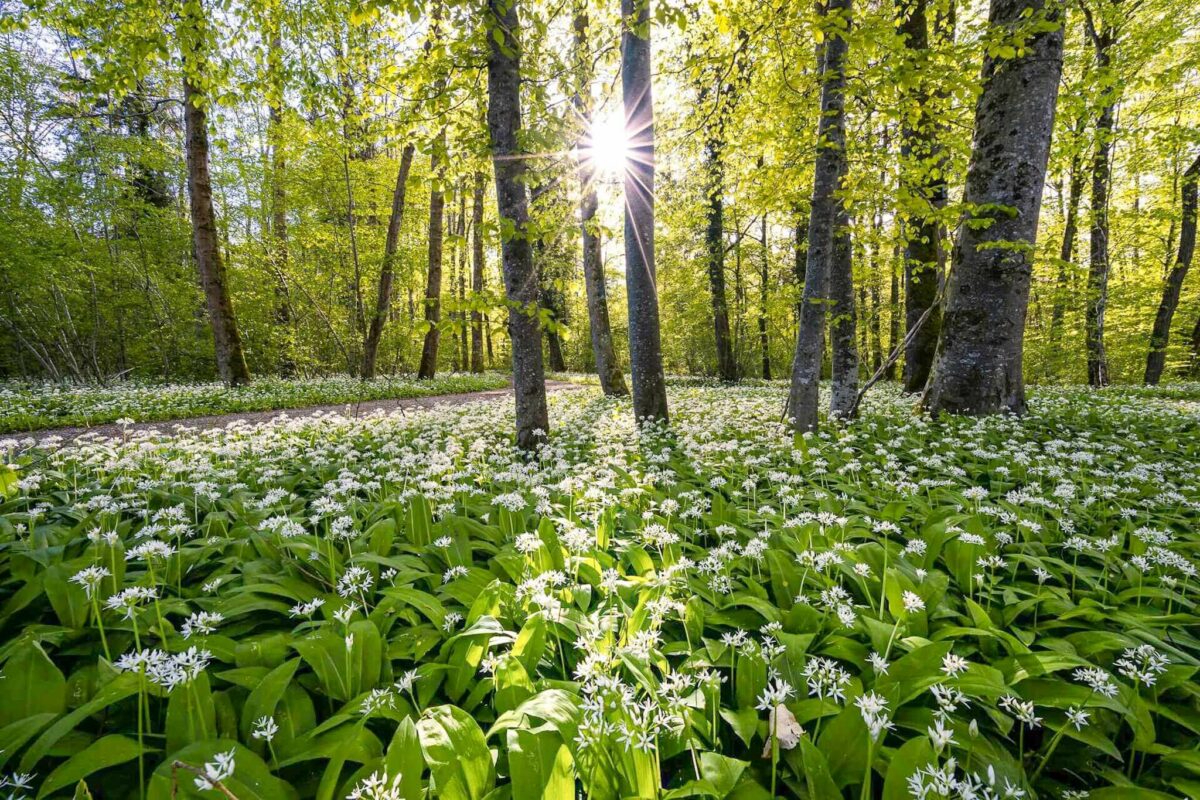
What is Wild Garlic?
Wild garlic is a member of the allium family native to Europe. In North America, a similar plant grows, locally known as “ramps,” or in scientific terms, “allium tricoccum.” Although similar at first glance, these are different genies of the wild garlic family.
As the name suggests, the plant is the wild relative of the domesticated garlic we all know and love to use regularly in our cooking.
Wild garlic grows in large swathes and is identifiable by long, smooth, and broad leaves with a distinctive, pungent garlic smell. Depending on the weather, it first emerges in mid-March of April, then blooms into bursts of small white star-shaped flowers from April to June.
All parts of the plant are edible, from the bulbs, stems, leaves, buds, and flowers.
Where to Find Wild Garlic
The tasty plant grows rampant across Europe. You’ve likely walked past a patch without noticing — you need to know where to look!
Specifically, seek out areas of woodland close to water sources like the sea, rivers, or streams — the wild herb enjoys a moist, shaded environment. In the U.K., it grows particularly well in ancient woodlands, although it’s common to find growth in modern parks, too.
It’s crucial to note that different areas of the country will see wild garlic earlier than others, depending on the weather and relative warmth. For example, it’s not unusual for the South West counties, like Cornwall and Devon, to see the first wash, while Scotland comes much later in the season.
How to Harvest Wild Garlic
Wild garlic is often anointed “the beginner’s forage” due to its relative abundance, accessibility, and ease of identification. However, there are still a number of points to consider.
Firstly, indentification. Prior to foraging, study the size and appearance of wild garlic. The plant has lookalikes: bluebells (which appear concurrently), lily of the valley, snowdrops, lords and ladies, and even daffodils can, to the untrained eye, seem like wild garlic. All those doppelgangers are dangerous to ingest — some can even be deadly. Accurately distinguishing the plant can be the difference between life and death.
Don’t just use your eyes. In addition, use your sense of smell! Wild garlic leaves have an intense garlicky aroma when rubbed between the fingers.
Instead of picking multiple leaves at once, be mindful when foraging. Poisonous plants can grow amid a patch of wild garlic, so heightened awareness is paramount. Plus, it’s the forager’s rule to never pick too many leaves from one plant — always spread your foraging out, and never plunder a patch clean.
Finally, it’s illegal to pull wild garlic bulbs in the U.K. Instead, stick to picking the leaves, flower bulbs, or bloomed flowers.
Take a small bag or basket, and happy foraging! Try to pick from places off the beaten path to avoid the likelihood of dog urine, and always thoroughly wash the leaves once you arrive home.
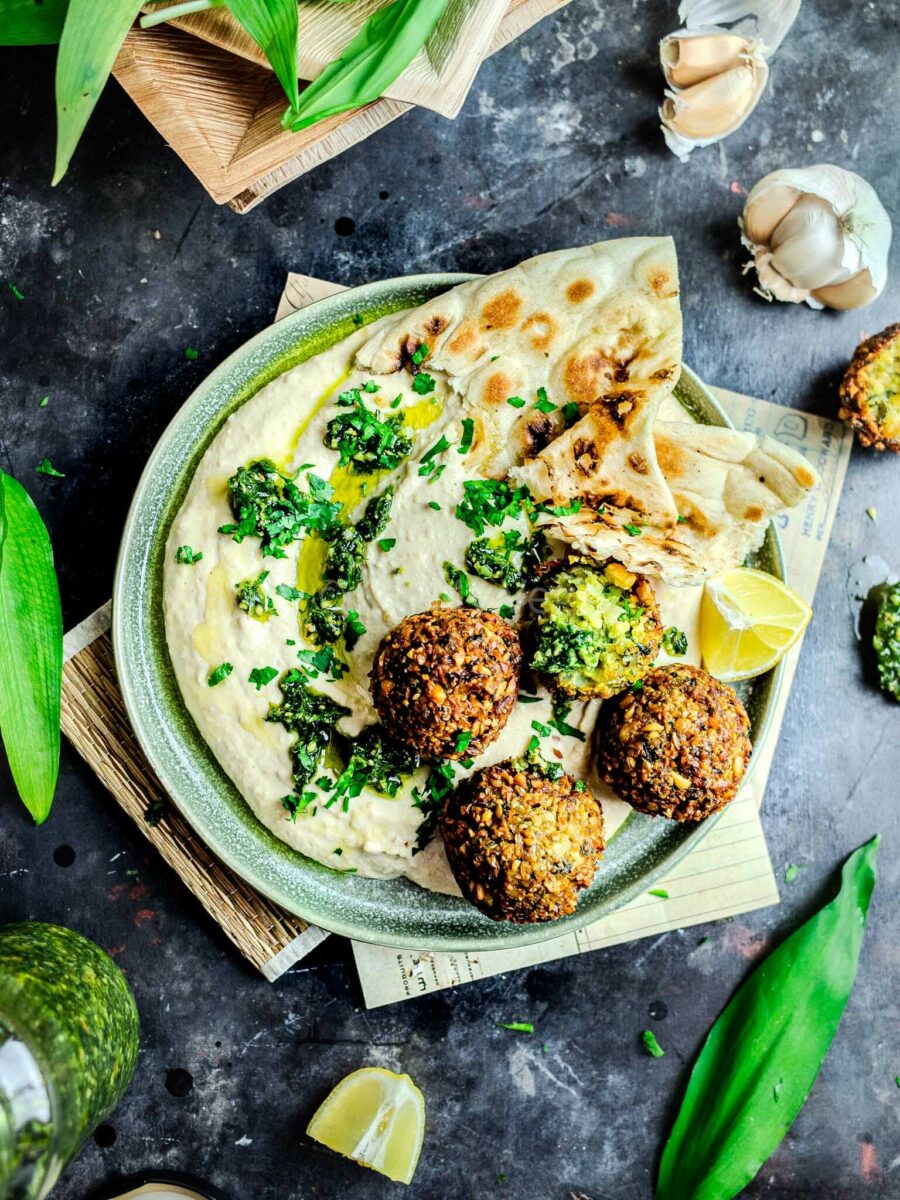
Ingredients You Need for Wild Garlic Falafel
The formula for these wild garlic falafels is based on my classic homemade falafel recipe. As they say — if something isn’t broken, don’t fix it!
Most of these ingredients should be pantry staples, except wild garlic. Here in the U.K., I forage for wild garlic (more information above), but in some European countries, the fresh herb is available to buy commercially, and you may be able to source some in local farmers’ markets.
If you’re missing any dry ingredients, my Amazon storefront is a fantastic place to start shopping.
- Chickpeas form the basis of Middle Eastern falafel. You must use dried chickpeas, not canned chickpeas! Tinned/canned chickpeas will produce a horrid paste-y texture, whereas dried chickpeas have a perfect tender and nutty interior with a crisp outer layer.
- Wild garlic mixed with the other ingredients adds bright green vibrancy to the vegan falafel in color and flavor.
- Chickpea flour acts as a binder, helping these falafels to stick together. The wild garlic adds extra moisture, requiring slightly more binder than usual.
- Dried spices such as coriander and cumin add earthiness to complement the chickpeas, while red chili supplies just a touch of heat.
- Onion is an allium, like wild garlic, but has a milder pungent bite.
- Lemon adds brightness to the wild garlic falafels, working beautifully with the freshly foraged ingredients.
- Salt and pepper are essential to balance out the seasoning.
- Baking powder is optional but helps with a texture in the falafels that’s to die for.
- Neutral oil is needed to deep-fry the falafels, although you can also air-fry them (more info on that later!)
Wild Garlic Allergens
As someone with a “limited diet” (I say that in quotation marks because, in reality, it’s anything but limited!) I love sharing recipes that fulfill a wide variety of dietary requirements. These vegan wild garlic falafels fit that characterization to the tee.
- Wild garlic falafels are 100% vegan and dairy-free, containing no animal products. Sometimes, people serve the snacks with non-vegan accompaniments like tzatziki, but since you’re making these at home, you control the side dishes! I instead opted for my smooth and creamy hummus topped with wild garlic pesto.
- This wild garlic falafel recipe is gluten-free, as I use chickpea (garbanzo bean) flour to bind the balls together. Apart from the benefit of being gluten-free, this works much better flavor-wise as it melds seamlessly with the chickpea-based foundation.
- Although we often describe falafels as nutty, these wild garlic falafels are nut-free too. Chickpeas may have undertones of nutty nuance, but they’re a legume, not a nut, making falafels 100% safe for anyone with a nut allergy.
- Finally, wild garlic falafels are a soy-free recipe, a big bonus if you’re plant-based and allergic to soy!
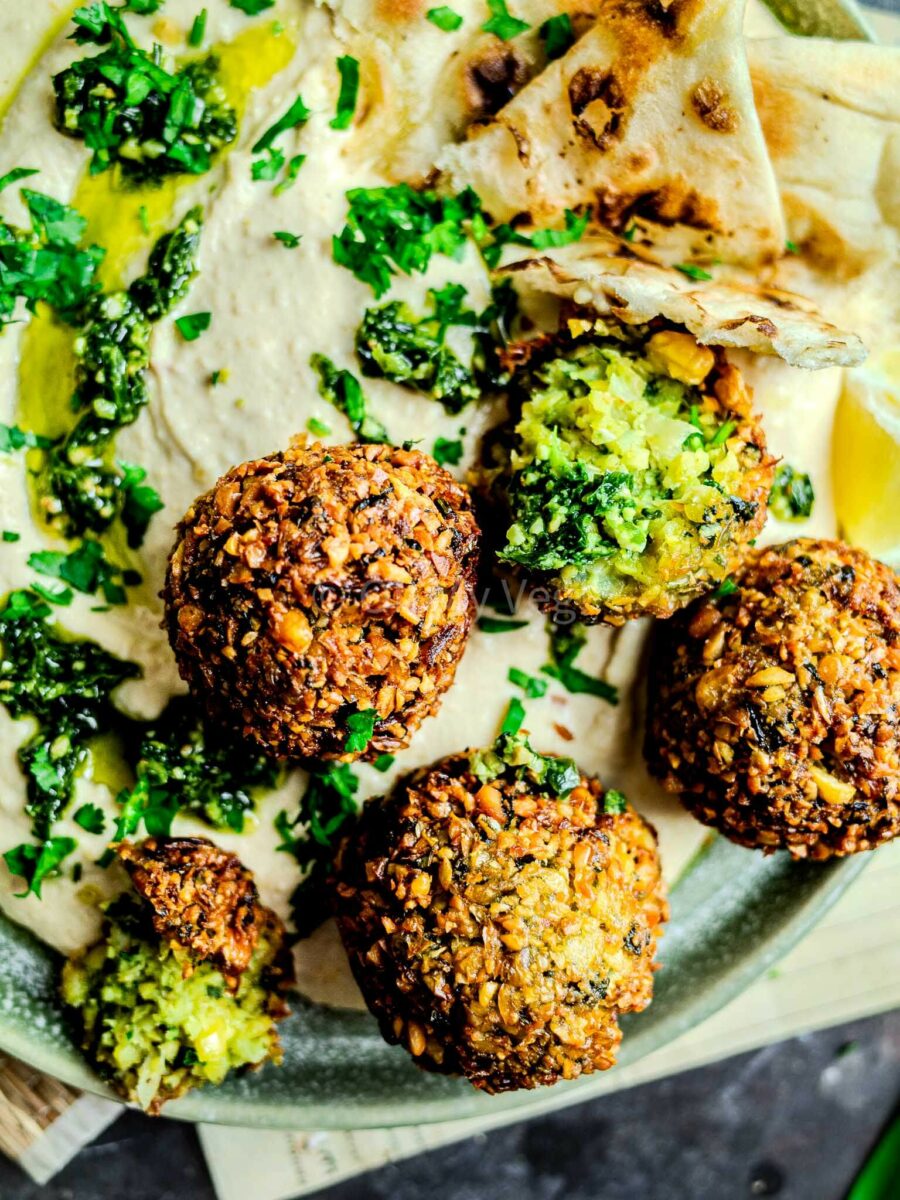
How to Make Wild Garlic Falafel
Although it takes some planning in advance (the chickpeas need soaking overnight), the technique for making homemade wild garlic falafels is almost unbelievably straightforward. It’s the perfect recipe for beginner cooks!
- Soak the chickpeas overnight to soften the legumes.
- Process the chickpeas with wild garlic, onions, dried spices, lemon juice, salt, ground pepper, and baking powder until they look like couscous.
- Mix the chickpea flour to bind the falafels and press them into balls. Chill.
- Deep-fry the wild garlic falafels until deep golden brown.
Alternatively, to cook falafel without deep-frying, you can bake or air-fry the snacks! They may not be quite as crispy, but nonetheless inviting.
- To bake falafel, preheat your oven to 200 C (392 F). Prepare a baking tray with parchment paper, arrange the falafels, and brush with olive oil. Once the oven comes to temperature, bake for around 30 minutes, turning halfway through, until golden and crisp.
- To air-fry the wild garlic falafel, preheat the air-fryer to 180 C (356 F). Spray or brush your air-fryer basket with neutral oil. Arrange the falafel inside without overcrowding, and brush the falafels with more oil. Air-fry for around 8 minutes, then turn and cook the other side for an additional 8 minutes. You may have to cook the wild garlic falafel in batches.
- You can also pan-fry falafel. Use a large, deep-sided, non-stick frying pan and add an inch of neutral oil over medium heat. Once the oil is hot, carefully add the falafels. Fry for around three minutes on each side until golden.
Cookware You Need
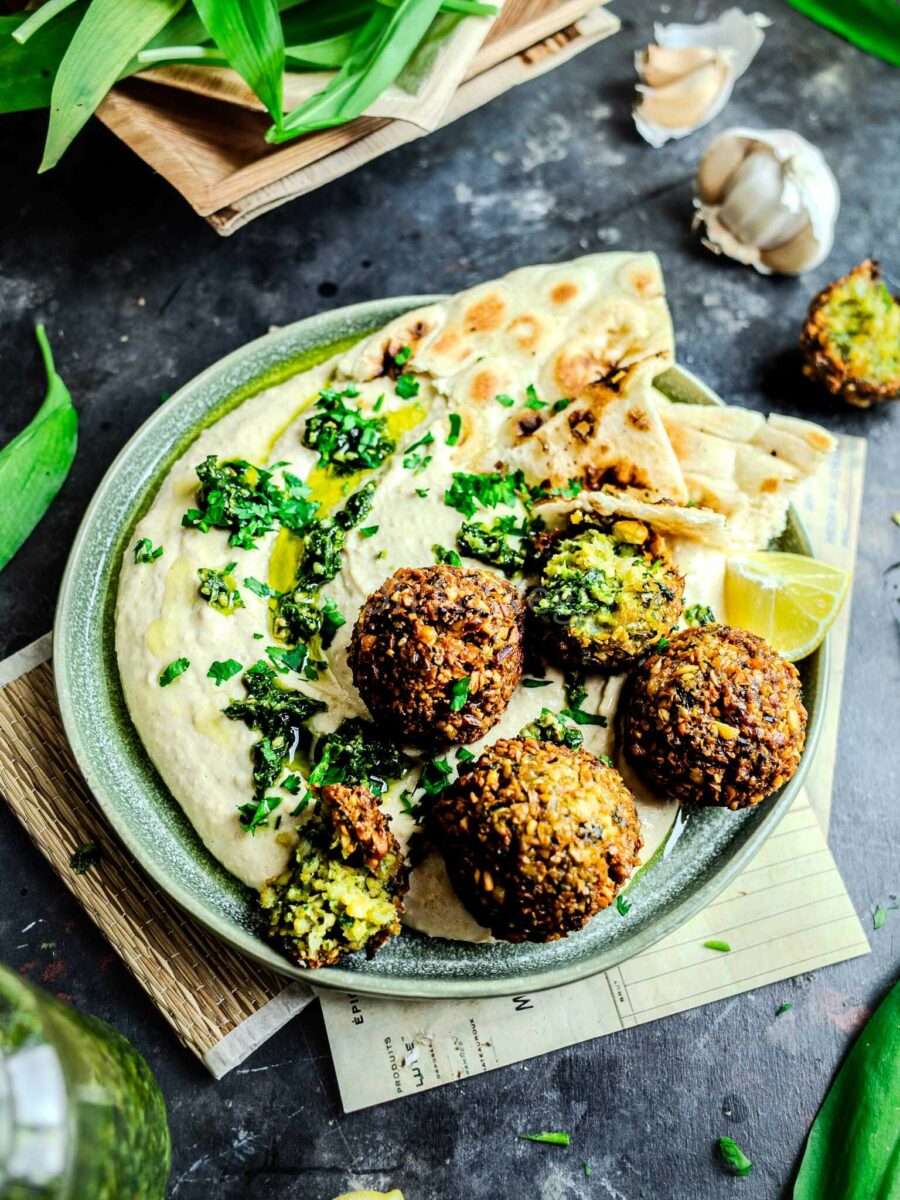
How to Serve Wild Garlic Falafels
Falafels are wonderfully versatile! You can serve the treats as a snack alongside a dip (vegan aioli or tahini sauce is my first choice) or make them part of a large meal with bread, salads, and grains.
Here are some suggestions:
- Serve falafels with hummus garnished with olive oil and wild garlic pesto. Use my soft and fluffy garlic naan to mop it all up.
- Sandwich the wild garlic falafels in pita bread with salad and a drizzle of hummus or tahini sauce.
- Place falafels on top of vegetable couscous for a lighter variation of a Middle-Eastern meal.
- Beetroot hummus with the wild garlic falafels mixes things up and introduces vibrant color.
How to Store and Reheat Falafel
Want to make these wild garlic falafels ahead of time? There are a few options:
- Freeze the uncooked falafel balls on a baking tray lined with parchment paper. Once frozen, place them into a freezer bag and store until ready to cook. You can deep-fry, bake, or these from frozen — bear in mind the vegan falafels will need more cooking time.
- Cook the falafels through, and then store them in the refrigerator for up to three days or freeze for up to three months.
You can enjoy wild garlic falafels cold (they are particularly great for picnics!) and reheat them. I don’t recommend reheating in the microwave as you’ll lose that lovely crunchy and crisp exterior texture. Instead, for the best results, I advise cooking them in a preheated oven for around five minutes or until warmed through.
This Recipe Is:
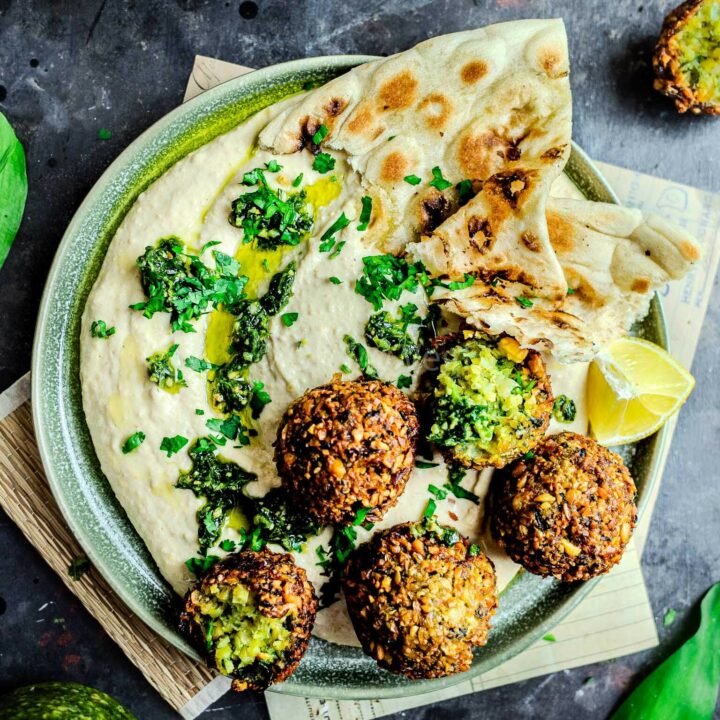
Wild Garlic Falafels
Ingredients
- 220g Dried Chickpeas
- 80g Wild Garlic (1 Large Bunch)
- 2 tbsp Chickpea Flour (Garbanzo Bean Flour)
- 60g White Onion
- 1 tsp Coriander Powder
- 1/2 tsp Cumin Powder
- 1/2 tsp Red Chili Powder
- Juice of 1/4 Lemon
- 1 tsp Salt
- 1/8 tsp Baking Powder
- Black pepper, to taste
- 1 lt Neutral Oil, to deep-fry
Instructions
- Soak the chickpeas overnight. Add the dried chickpeas and more than double the amount of water to a large bowl. Cover the bowl and leave them to soak overnight. The chickpeas will more than double in size.
- Process the chickpeas. Add chickpeas to a food processor. Pulse until they look similar to fine couscous.
- Remove half the chickpeas in a large bowl, then add the wild garlic, onions, dried spices, lemon juice, salt, ground pepper, and baking powder to the remaining chickpeas. Pulse again until everything is finely chopped.
- Shape the wild garlic falafels. Add the chickpeas you pulsed with the seasonings to the large bowl. Mix in chickpea flour and stir until everything is evenly incorporated. Press them into tight balls (you will have to squeeze).
- Chill the balls in the fridge while you heat the oil.
- Deep-fry the falafel*. In a deep saucepan or deep-fat fryer, heat neutral vegetable oil until it reaches 180 C or about 350 F. Carefully lower the falafel into the oil and cook until golden brown. Drain on kitchen towel. Repeat the process, cooking in small batches of three at a time.
Notes
*If you're not comfortable deep-frying the falafel, there are other cooking options:
- To bake falafel, preheat your oven to 200 C (392 F). Prepare a baking tray with parchment paper, arrange the falafels, and brush with olive oil. Once the oven comes to temperature, bake for around 30 minutes, turning halfway through, until golden and crisp.
- To air-fry the wild garlic falafel, preheat the air-fryer to 180 C (356 F). Spray or brush your air-fryer basket with neutral oil. Arrange the falafel inside without overcrowding, and brush the falafels with more oil. Air-fry for around 8 minutes, then turn and cook the other side for an additional 8 minutes. You may have to cook the wild garlic falafel in batches.
- You can also pan-fry falafel. Use a large, deep-sided, non-stick frying pan and add an inch of neutral oil over medium heat. Once the oil is hot, carefully add the falafels. Fry for around three minutes on each side until golden.
Recommended Products
As an Amazon Associate and member of other affiliate programs, I earn from qualifying purchases.
Nutrition Information:
Yield: 3 Serving Size: 1Amount Per Serving: Calories: 396Total Fat: 13gSaturated Fat: 2gTrans Fat: 0gUnsaturated Fat: 10gCholesterol: 0mgSodium: 952mgCarbohydrates: 61gFiber: 9gSugar: 15gProtein: 11g
Nutrition information isn’t always accurate.









